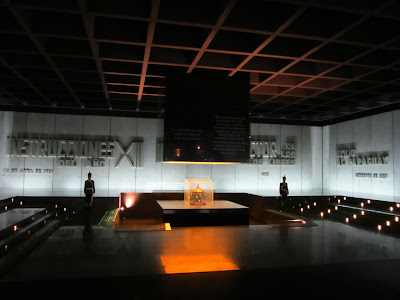 |
| General Artigas, June 19th 1764 - September 23rd 1850. |
It is well worth seeing as it contains several sights of interest. The Teatro Solis, a beautiful theater/opera house sits diagonally across from it.
The finally finished (43 years) "new" presidential office building called the Executive Tower graces another side of it and so does the Palacio Salvo.
The Palacio Salvo is a stunning example of a 1930's Italian Gothic and mixed styled classic building, once the tallest building in Latin America.
However, smack dab in the middle of this spacious palm tree lined space with its accompanying park benches is a grand equestrian statue of a horse and its rider, General José Gervasio Artigas.
General José Artigas is the Uruguayan equivalent to the USA's General George Washington.
He is a national hero down here and is often called the "Founding father" of Uruguayan Nationhood.
There are many books and articles that historians have written about him. I have linked his name to a wikipedia link for more information about his life and for your convenience. Briefly, He is said to be instrumental in founding the move for independence here in Uruguay, (the name of the plaza). He fought against the Royalists of his day and was concerned about equality for all. He fought for civil liberty and religious freedom and he wanted to have a Republican Constitution. As a military man, he fought in the calvary hence the equestrian statue.
What many people might not know is that underneath this landmark lies his tomb, holding an urn with his ashes. There are 2 different stair cases (1 on each side) that you can choose from, to take you down to his underground mausoleum. There is NO admission charged!
As you descend the granite lined walls and stairs, you can see how weighty a person General Artigas is in the minds and hearts of Uruguayans. The use of granite is extensive! A lovely brown is used along your trip down. Then you come underground into his tomb and find yourself in a massive, dimly lit room/shrine to the man.
The darkness is at first intense as the floors are now covered in black granite. I had to bend down and look very closely at the first steps to greet me inside so as to be able to navigate them.
Inside this underground mausoleum, the impressive concrete walls are covered with some dates surrounding important political events in his career and the dates of his birth and death.
Two soldiers stand guard, at attention, flanking his urn. It is guarded 24 hours a day, 7 days a week. The guards are like the ones guarding Buckingham Palace in England in that they don't move, speak or look at you. This meant that I could take as many pictures as I wanted inside without being scolded.
There are 3 massive black granite steps that lead you down closer to the urn holding his remains. I went closer and took a couple of pictures of it while the soldiers ignored me, keeping their eyes straight ahead, staying at attention.
It was interesting being so close to such an important link in the history of the Uruguayan people and their country. Of some note, a monument to General Artigas also stands in Washington, D.C. USA.
I took the other stair way back up to the plaza level and had a nice view of the Palacio Salvo greeting me at the top of the stair. I had tried to visit this mausoleum years ago but it had been closed for renovations and his ashes removed. So I am glad that it is open to the public. It's well worth the visit.












3 comments:
Wonderful article, Denise.
Wonderful article, Denise.
Indeed, very interesting article. I am happy to hear that the underground mausoleum is now open as it was under reconstuction on my last trip to Montevideo.
You might be interested in knowing that, in addition to the one in Washington, DC there is a monument (statue) of General Artigas in SoHo square in lower Manhattan (NYC) on 6th Avenue and one in Montevideo, Minnesota (which is a sister city to Montevideo, Uruguay -- although it is pronounced differently). There is also at least one in Asuncion, Paraguay that I know of. By the way, Artigas died in Paraguay in 1850.
Regards,
Felipe
Post a Comment